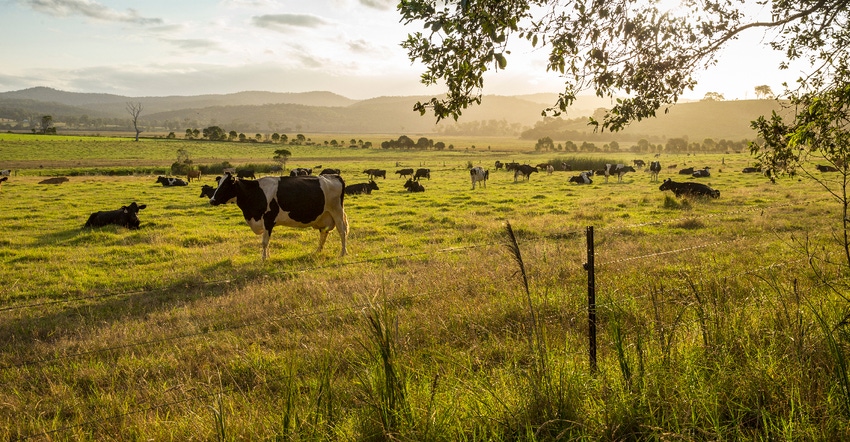
There are many things that go into making a good hay crop, from timing to equipment and, of course, the weather.
But there are many ways to improve persistence and productivity of forage stands, says Amanda Grev, Extension forage specialist with the University of Maryland.
Here are eight things Grev says producers should focus on if they want persistent forage stands every year:
1. Maintain potassium levels. In many ways, forage persistence starts with potassium. “Potassium is for persistence," Grev says. "We know this is one of the key nutrients plants need to persist and survive in the long term."
Potassium deficiency happens when forage is harvested and the nutrient isn’t replaced. Depending on the forage, it ranges from 60 pounds of potassium removed per ton of alfalfa dry hay to 35 pounds of potassium removed from warm-season grasses.
Grazing, on the other hand, results in less nutrient removal, Grev says, because of nutrient recycling from manure or urine.
But it’s not as simple as just putting your cattle out on the field instead of cutting or mowing. Cattle move around, and the nutrients they uptake might will likely not come out uniformly. Rotational grazing helps, Grev says.
Potassium deficiency can be seen in grasses or legumes. In clover, for example, you might see whitish spots on the margins of the leaf, she says, while in grass you’ll likely see some brown streaking.
2. Adjust soil pH. Soil pH affects the utilization of key nutrients. If soil is more acidic, nutrients such as aluminum, iron and copper become more readily available, whereas the essentials like potassium become less available, Grev says.
A neutral soil pH — between 6.0 to 7.0 — is the ideal range for plants to uptake nutrients, she says. Soil that’s too acidic also reduces root growth and development, and plants won’t be able to extract nutrients and water from the soil. There also is less mineralization of organic nitrogen and less nitrogen fixation.
Keep in mind, though, that different species have different tolerance to acidity. Alfalfa and sorghum-sudan have poor acid tolerance, Grev says, while red and white clovers can tolerate it a little better. Some grasses are better than others. Orchardgrass and Kentucky bluegrass have “fair” tolerance to acidity, while bermudagrass and pearl millet have excellent tolerance.
3. Control foliar disease. Many fungal diseases, such as leaf spot, can affect your forage. In fact, Grev says at least 30 fungal diseases are known to affect orchardgrass, the most common being rust, scald and leaf spot.
Fungal pathogens get their energy by stealing carbohydrates stored in plant tissue, reducing forage quality and palatability, and weakening overall plant health. Wet or drought conditions can make the situation worse.
To reduce the risk, Grev says it’s important to address fertility, harvest at a good time and graze a field to remove potential inoculum.
If you irrigate, good management is crucial. For example, turning off the system by midafternoon at the latest will give plants plenty of time to dry before nightfall.
Rotating grass and legumes in certain situations also is key to break the disease cycle, Grev says, as different diseases affect each species.
4. Manage overgrazing. Plants need time to regenerate carbs, so allowing a good rest time following grazing is important, Grev says. It allows plants to recover quicker.
Overgrazing also can affect things below the surface, shortening root growth, so this is something to keep an eye on.
5. Lower cutting height. Modern disk mowers are efficient and can generate excellent yields, but they can cut very close to the ground, resulting in more scalping. This can be bad for quick regrowth, Grev says.
A plant needs sun and moisture to generate photosynthesis. The leaves of a plant are important to continue that process and allow for better regrowth.
Most grasses store carbs in the stem, especially in the lower 3 to 4 inches. This is important to think about, Grev says, if you’re cutting too low and need to raise the cutting bar.
6. Manage around extreme weather. As climate change leads to longer growing seasons and hotter summers, cool-season grasses and forages will be affected in the long term.
The mid-Atlantic is a transition zone, Grev says, as it is the farthest south that some cool-season grasses can grow. As a result, most forage production in the region gets done in spring and fall.
But you can help Mother Nature, she says, by adjusting the cutting bar and not cutting too low. This has the effect of moderating the soil temperature since there is more surface growth, allowing for better and more persistent regrowth.
7. Go with earlier cuttings. The length of harvest intervals can affect longevity of a forage or grass stand, Grev says.
Cutting earlier, especially the first cut, can result in less heat stress and moisture than cutting in the middle of a hot and dry summer day, and can lead to better regrowth for subsequent cuttings.
8. Control weeds and insects. Treating weeds is important as they can often compete with forages for light and nutrients, and shade desirable crops.
Grubs, bill bugs and armyworms can also affect forage and grass persistence. They can feed on roots and cause problems with long-term persistence, but these tend to be an aftereffect of other things.
If you are having trouble with persistence, Grev says that it could be a result of many things, like a combination of high temperatures and lower cutting height.
It’s important to think about changes you can make now before growing season starts to ensure good stands come spring and summer.
About the Author(s)
You May Also Like






